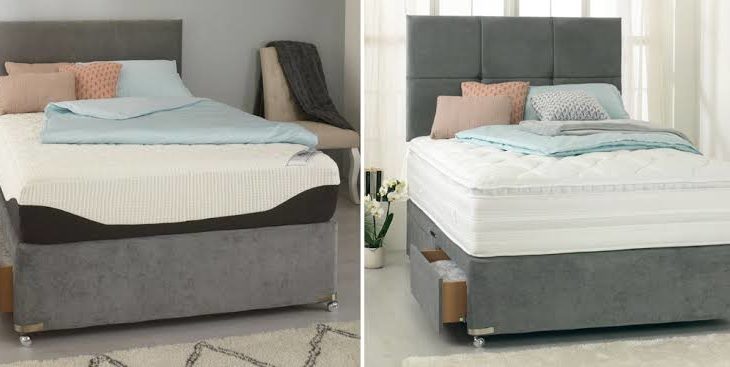One of the most critical aspects of our health is our sleep and rest patterns. But as technology progressed, it has become evident that where we sleep has become more important. So now comes the question of which is better, foam or spring mattresses? Here, we discuss in depth the differences between spring and foam mattresses, so you can decide which is better suited for your needs.
What Is A Spring Mattress?
Spring mattresses are often referred to as the “traditional” mattress or the predecessor of the foam mattress. They are made with plenty of metal coils suspended in other materials that make up the mattress. They offer a lot of support, particularly for those with back ailments, as well as those who are heavier.
Spring Mattress Construction
Spring mattresses have a layer of coils with varying density at the center. These provide the majority of structure to the bed, along with bounce and support. Several factors can have an impact on the feel of a spring mattress — the type of spring, the thickness of the metal which makes the spring, the amount of spring, and how they all connect.
The coils are then encased in a foam layer with varying types of upholstery to add comfort. With this arrangement, the mattress core of springs is the “support layer” while the upholstery is the “comfort layer.”
What Is A Foam Mattress?
Foam mattresses rely on air trapped within aerated substances to offer bounce and support. Foam mattresses are generally classified into three broad types: polyurethane foam, memory foam, and foam latex.
Polyurethane (“Poly”) Foam
Polyurethane foam is commonly known as the uppermost layer in an innerspring mattress. A single layer of polyurethane can be constructed into part of a polyurethane foam mattress. Chemically, it has a similar structure to memory foam, but without any viscosity boosters, making it much more bouncy and springy than memory foam. It’s also lightweight and is one of the easiest mattresses to maneuver.
Memory Foam
Memory foam mattresses are made of several layers of various densities of foam. The foam molds around the contours of the body and have a slow bounce back (this means that it retains the body’s shape for a few seconds after being indented.) It can be of great help to those suffering from back or joint pain, as it relieves pressure on these areas of the body.
Foam Latex
Foam latex is created by aerating a sap-like substance to create air bubbles. This results in a firm but bouncy support, which is uniform throughout the bed. Unlike memory foam, latex offers superior firmness and pressure relief. Foam latex also has an environmental benefit over memory foam, since the raw materials are natural and the production process is immaculate.
What Are The Differences Between Spring And Foam Mattresses?
There is a massive variance between a foam or spring mattress, and choosing between them can be tricky. Of course, there are benefits and drawbacks to either choice, depending on the customer’s preferences. Here are the different categories where the differences between the two become apparent.
Cost: There are both spring and foam mattresses available for any budget, whether you’re looking to splurge or if you’re looking for something more affordable.
Durability: Foam mattresses are generally considered to be more durable and long-lasting, and this is typically reflected in their more extended warranties. Unfortunately, spring mattresses can decrease in comfort after prolonged use, due to the springs becoming less uniform and more prone to sagging and poking.
Support: Those with severe back pain are generally pointed to memory foam mattresses as they support the natural curvature of the spine and keeps it in alignment.
Movement Absorbency: If you share a bed with a restless sleeper, a spring mattress may become an issue. As spring mattresses bounce back, anyone moving in the bed will cause you to move around too. A foam mattress is generally better at absorbing the movement.
Temperature: Memory foam is susceptible to trapping heat since it relies on the heat of the body to become more malleable. It then retains the heat — which can be uncomfortable for those living in a hot climate. Spring mattresses are generally a cooler option than foam; however, there are many foam and hybrid options with features specifically included to cool the sleeper.
Quality and Price Range: Because spring mattresses have been around for so long that there is often a wider variety of them on the market. They can offer a wide range of firmness levels, support, and feels, all across a more extensive price range than newer foam models.
Scent: Foam mattresses have been reported to have an unpleasant, chemical smell. While it can fade after unboxing, the smell makes the initial experience of sleeping on it noticeable.
Sleeping Position: People who sleep on their stomachs favor foam latex mattresses, as they can be firmer. Back sleepers tend to like a firm and soft hybrid, so a traditional spring mattress could be a good option. Side sleepers generally prefer something more delicate to cushion the shoulders and hips, so memory foam may work best.
Personal Preference: Ultimately, the decision when it comes to choosing the best mattress comes down to what you want and need. Spring mattresses may lack uniformity, but the enveloping feeling of foam can equally be a turn-off. Once you’ve done your research, it’s crucial to take into account your individual preferences as opposed to reading reviews based on other people’s opinions. What may feel right for them may not be right for you.
